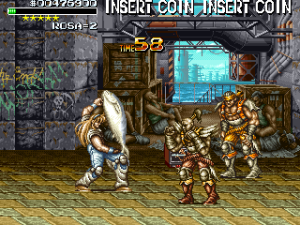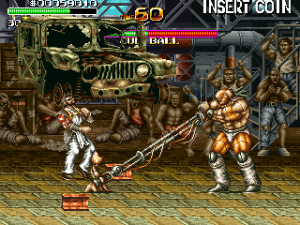Undercover Cops
Through the very late ’80’s and into the early ’90’s there probably wasn’t a single major arcade manufacturer who did not publish a scrolling beat ’em up of one kind or another. Double Dragon, Altered Beast, Teenage Mutant Ninja Turtles are some of the releases that roll off the top of my head, and of course there was Capcom’s seminal Final Fight and the slew of games that followed, both in the arcade and on home consoles, trying to emulate its success and format.
It’s easy to credit Technos’ 1987 hit Double Dragon as the game that really kick started the demand for scrolling beat ’em ups, and Double Dragon certainly was innovative for its time, but it is Irem’s Kung Fu Master that can be seen as the first landmark title in the genre. Nevertheless, Irem never really pursued the scrolling beat ’em up further, instead generally relying on a steady stream of high quality shoot ’em ups to make its name, (chiefly through 1987’s R-Type).
Released on the powerful M-92 hardware, Undercover Cops hit Japanese arcades in the Summer of 1992 in what would become one of Irem’s final commercial successes before their arcade division was wound up, and their penultimate scrolling beat ’em up (their last being the obscure and imaginatively titled Ninja Baseball Bat Man).
Having more than proved themselves capable of doing a decent shoot ’em up, could Irem work their magic on a scrolling brawler, in the face of the high standards already set by Capcom?
The premise of Undercover Cops is as flimsy as just about any other scrolling beat ’em up from the era – in the year 2043, New York City has become over-run by crime, and the mayor and city officials have called in three specialists, dubbed “City Sweepers”, to come kick ass and ask questions later. Thus the scene is set for you and your character, plus a friend in two player co-op, to go in and defeat the minions of the evil Dr Crayborn.
With credits inserted you have the choice of three playable characters each with their own individual strengths and weaknesses. So, as either Zan Takahara, Matt Gables, or Rosa Felmonde, you will punch and kick your way across five stages to save the City and win the day. Each character has your standard punch and kick moves, plus two desperation moves which help you out in the tighter situations you find yourself in. However, as with Final Fight, pulling off either your desperation or super-desperation moves will cost you a chunk of your character’s remaining energy bar.
A novel feature that helps to encourage plenty of direct action against your enemy is that at the end of every stage you get rated for your performance in disposing of your enemies. Surpass your “finesse” (spelt “finess” in the game) target score and you can benefit from bonus energy and additional lives, plus a better score. The action itself is pretty text book – punch, kick, repeat to defeat your foe. Each playable character has their own move set and animations, with your enemies having a limited set of responses to try and stop you. The five stages are each of a decent length, but as the game wears on, the enemy doesn’t vary greatly and you tend to have the levels loaded with the same enemy creating a degree of repetition, which in many respects is a staple issue of scrolling beat ’em ups, but it feels more or a chore than usual with Undercover Cops when compared with either Final Fight or Streets of Rage 2. Both Capcom and Sega’s efforts cleverly break up the monotony of the minion enemies, but by Stage 5 of Undercover Cops a stagnation begins to set in which takes the sheen off the game.
The sprites are excellent. The three protagonists are each individual in their appearance, well drawn and distinctive. Thought has also gone into the enemy the sprites as well, making them stand out well against the usually less creatively styled enemies of other scrolling brawlers. The stages are well drawn but they are not particularly original in concept, although the end of stages 1, 3 and 4 are well executed with some original features. The final stage is a bit of a let down, with the majority of it set on-board a giant helicopter; that is, sadly, rather blandly drawn inside. On some stages, the first in particular, there is still the Irem trademark of high detail in the backgrounds, but across the game not to the level as seen in Gun Force II or In The Hunt. Indeed, the first stage is arguably the best stage of the five – the backgrounds have plenty going on, there’s lots of detail, and there are plenty of items to pick up and utilise against the enemy along with a decent end boss battle. From there on in, the subsequent levels fail to match this for some reason.
While it does try its best to do things differently, Undercover Cops fails to do anything particularly original. The enemy attack patterns become repetitive after a while, there just isn’t enough variety within the stages, although credit has to be given to the end of stage bosses. This is where the game becomes memorable and at its most challenging. All five bosses are very original in appearance, drawn to a high standard, well animated and given plenty of creative character. They’re also pretty cheap with their attacks, with only Parcs and Balbarotch relatively straight forward to dispatch.
As one comes to expect with Irem’s late efforts, the graphics are highly detailed sprites with excellent animation as I have already alluded too. The music is good, but not particularly memorable. The game is challenging, but generally enjoyable; a worthwhile addition to the roster of scrolling beat ’em ups if for nothing more than its highly distinctive style to help it stand out from the crowd. I would say it is definitely worth a play if you want an alternative to Final Fight without feeling you’re playing a total clone of the same (for example SNK’s Burning Fight).
The end sequence suggests room for a sequel but none was forthcoming before Irem stopped releasing arcade games in 1994. In late 1993, and exclusively on the Nintendo Game Boy, an RPG based on the game, Undercover Cops: Hakaishin Garumaa, was released. This was also, fact fans, the second-to-last game Irem release on Nintendo’s hand held.
The original arcade hardware comes in World and Japanese rom sets. An original Japanese M-92 board-set will be neither cheap or easy to acquire; the World board is a lot less desirable because of changes made to the game, and although not terribly common, it is cheaper than the Japanese board. There is also a third PCB release known as the “Alpha Renewal” version, which is a “fixed” version of the World rom set which restores the features from the Japanese ROM set.
Unfortunately outside of a now very expensive 1994 Super Famicom port by Varie, Undercover Cops is not available for play in any other format save for emulation. Unless you are either a big Irem fan, or simply a connoisseur of the scrolling beat ’em up, you would do better by spending far less money on Final Fight and Streets of Rage 2. Undercover Cops is an above average effort that could have been something exceptional if it weren’t for a few details that let it down. As it is, Final Fight, Streets of Rage 2 and Aliens Vs Predator are all superior entries into the genre. Undercover Cops is good, but it could have been great.
Undercover Cops
Version tested: PCB (Japanese ROM set)
Also available on: Nintendo Super Famicom





